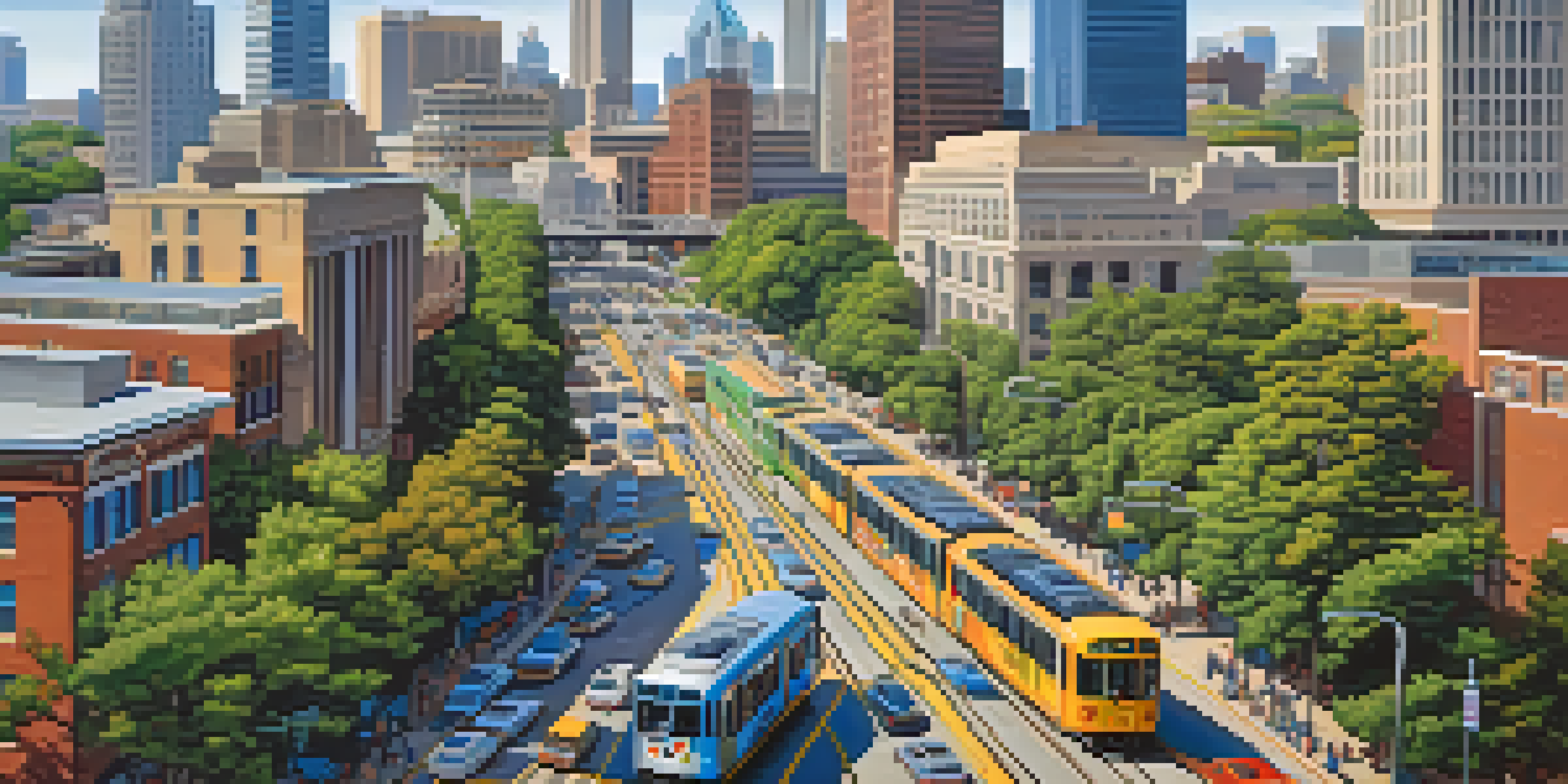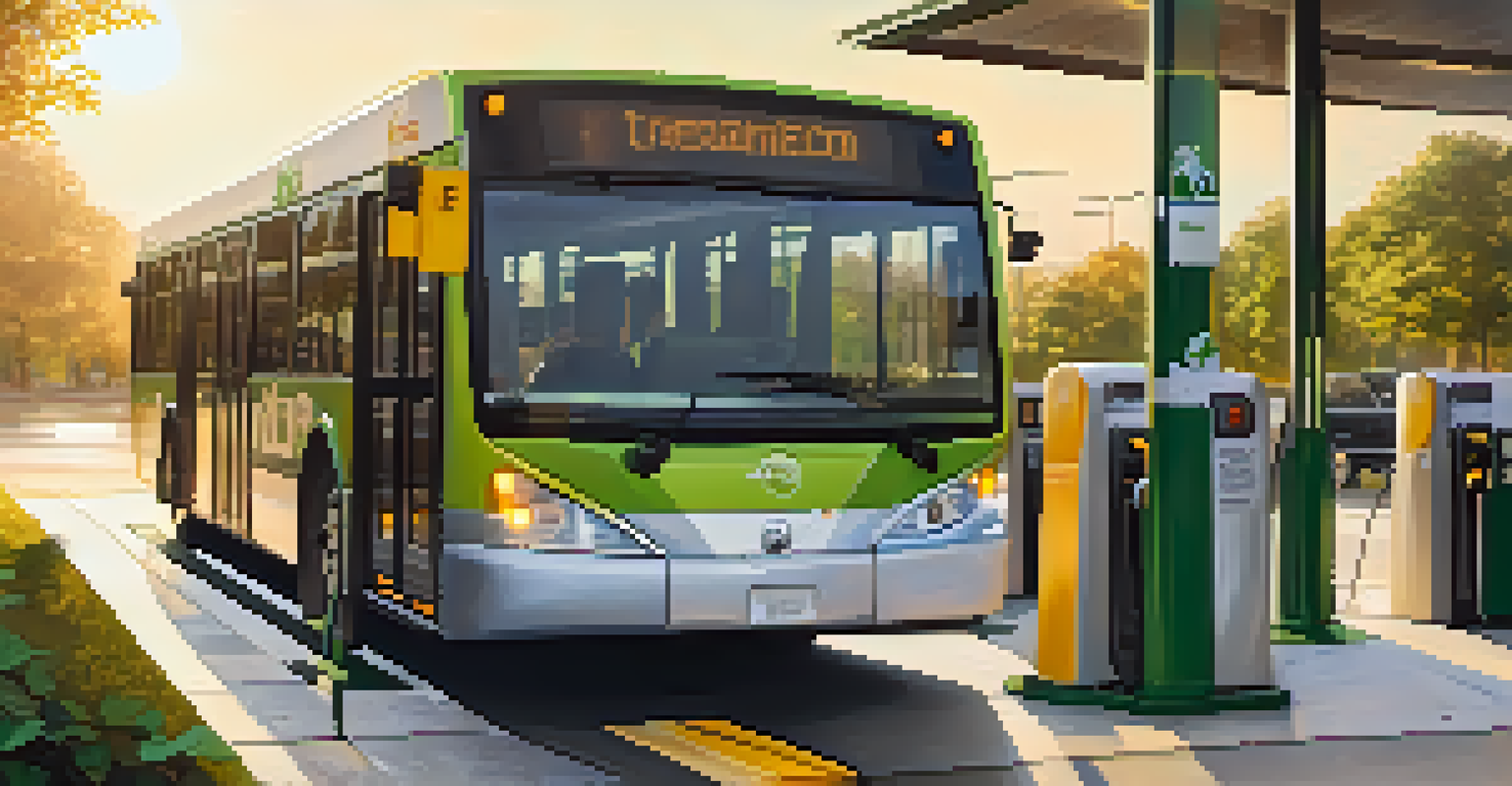Impact of Transportation on Atlanta’s Urban Growth Patterns

Understanding Atlanta's Unique Transportation Landscape
Atlanta is often recognized for its extensive transportation network, which includes highways, railways, and an international airport. This web of connectivity significantly influences the city’s urban growth patterns. For instance, the presence of major interstates like I-285 and I-75 has made it easier for residents to commute, thereby encouraging suburban expansion.
Transportation is the backbone of any urban area, shaping its growth and influencing the quality of life for its residents.
Moreover, the Hartsfield-Jackson Atlanta International Airport, one of the busiest airports in the world, plays a crucial role in attracting businesses and residents alike. As companies establish offices in the city, the demand for housing and services in surrounding areas increases. This push-pull effect between transportation infrastructure and urban development is a key aspect of Atlanta's growth.
As we delve deeper into this topic, it's essential to consider how transportation not only facilitates movement but also shapes economic opportunities and accessibility across different neighborhoods.
The Role of Public Transit in Urban Development
Public transit systems, such as MARTA, are vital for promoting sustainable urban growth in Atlanta. By providing reliable transportation options, MARTA encourages residents to opt for public transport over personal vehicles, reducing traffic congestion. This shift can lead to more walkable communities and vibrant city centers.

However, the coverage of public transit in Atlanta has faced criticism for not adequately serving all areas. Many neighborhoods remain underserved, limiting access to jobs, education, and essential services. Addressing these gaps is crucial for fostering equitable growth and ensuring all residents can benefit from urban development.
Transportation Fuels Urban Growth
Atlanta's extensive transportation network, including highways and public transit, significantly drives urban expansion and economic opportunities.
As public transit expands, it can also enhance property values in nearby neighborhoods, indicating a reciprocal relationship between transit accessibility and economic vitality. This dynamic is a pivotal factor in shaping Atlanta’s urban landscape.
Highway Expansion and Suburban Sprawl
The expansion of highways in Atlanta has historically contributed to suburban sprawl, where development spreads outwards from the urban core. While this growth offers more housing options, it often comes at the cost of green spaces and agricultural land. As families seek larger homes in the suburbs, the city’s character undergoes significant changes.
The most successful cities are those that prioritize accessible and sustainable transportation options for all their citizens.
Moreover, this suburban spread leads to increased dependence on cars, which can exacerbate traffic congestion and pollution. The challenge lies in balancing the desire for space with the need for sustainable urban environments. As Atlanta continues to grow, these considerations become ever more critical.
In response to these challenges, city planners are exploring mixed-use developments that integrate residential, commercial, and recreational spaces, fostering a more cohesive urban experience while mitigating some negative impacts of sprawl.
The Impact of Atlanta's BeltLine Project
The BeltLine project is a transformative initiative aimed at revitalizing Atlanta's urban landscape by repurposing old railway corridors into multi-use trails. This ambitious project not only enhances transportation options but also promotes economic development in surrounding neighborhoods. By connecting various parts of the city, it creates a sense of community and encourages local businesses to thrive.
As the BeltLine continues to expand, it is drawing more residents and visitors, further stimulating urban growth. The project emphasizes walkability and accessibility, contributing to a healthier lifestyle for Atlanta's residents. This focus on sustainable transport options is an essential step toward addressing the city's congestion issues.
BeltLine Enhances Community Access
The BeltLine project revitalizes Atlanta by converting old railways into multi-use trails, promoting connectivity and local business growth.
Ultimately, the BeltLine serves as a model for how innovative transportation solutions can reshape urban environments, making them more livable, vibrant, and interconnected.
Transportation and Economic Opportunities
Transportation infrastructure directly impacts economic opportunities in Atlanta. Areas with easy access to highways and public transit tend to attract businesses more readily, creating jobs and stimulating local economies. This trend highlights the importance of strategic transportation planning to foster economic growth across the city.
Additionally, improved transportation options can lead to increased foot traffic in commercial areas, benefiting local shops and restaurants. The economic ripple effect underscores how connectivity can enhance the overall quality of life for residents, making it a crucial element of urban development.
As Atlanta seeks to remain competitive in a global economy, investing in transportation solutions that promote accessibility and mobility will be essential. This will ensure that all communities can share in the economic prosperity the city has to offer.
Environmental Considerations in Urban Transportation
As Atlanta grows, the environmental impact of transportation becomes a pressing concern. Increased vehicle emissions contribute to air pollution, affecting public health and quality of life. Therefore, transitioning to more sustainable transportation options, such as electric buses and bike-sharing programs, is paramount.
Moreover, incorporating green spaces into urban planning can help mitigate some environmental impacts associated with transportation. Parks and recreational areas not only enhance city aesthetics but also provide essential ecosystems that contribute to overall urban resilience.
Sustainability in Future Planning
As Atlanta evolves, prioritizing eco-friendly transportation solutions is essential for balancing urban growth with environmental sustainability.
By prioritizing eco-friendly transportation solutions, Atlanta can work toward a future that balances urban growth with environmental sustainability. This approach fosters a healthier community while also addressing the looming challenges of climate change.
Future Trends in Atlanta's Transportation Landscape
Looking ahead, the future of transportation in Atlanta is likely to be shaped by technological advancements and changing societal needs. Concepts like autonomous vehicles and smart city initiatives are on the rise, promising to revolutionize how residents navigate the city. These innovations could lead to safer roads and more efficient transportation systems.
Furthermore, an increased emphasis on remote work has altered commuting patterns, prompting a reevaluation of how and where we invest in transportation infrastructure. As more people opt for flexibility in their work environments, urban planners must adapt to these changes to ensure that transportation systems remain relevant.

Ultimately, the intersection of technology, urban planning, and community needs will define the future of Atlanta’s transportation landscape, influencing how the city grows and evolves in the years to come.